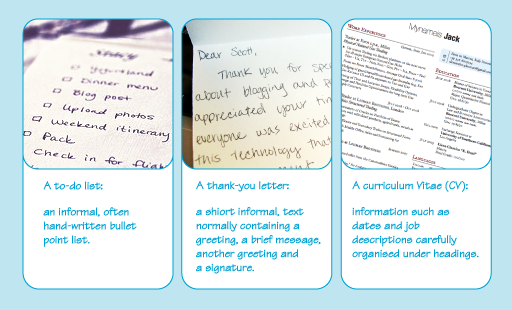Week 3: Writing university assignments
Use 'Print preview' to check the number of pages and printer settings.
Print functionality varies between browsers.
Printable page generated Friday, 10 May 2024, 9:42 PM
Week 3: Writing university assignments
Introduction
This week you will start to look at university writing, a very important student activity. You will first consider which aspects of your current writing will be useful when it comes to university-level writing and which might need a bit more work. Then you will move on to look at university assignments, their purposes and structure and the strategies students follow when approaching them.
Watch Anna describing what you will study this week:
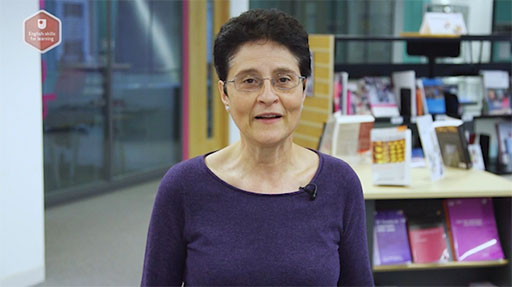
Transcript
Welcome to Week 3.
So far you have looked at reading: reading strategies and ways to use insights from readings in an assignment. Reading and selecting key information are two of the first steps towards writing a good assignment. It is now time to look at what university assignments ask for and how to produce a good assignment.
During Weeks 3, 4 and 5 you will concentrate on assignment writing. In particular, this week you will find out what types of assignments university students normally write, the reasons why they write them and the way they approach them. In Week 4 you will look in more detail at essay writing. In Week 5, you will learn how to clearly link ideas in your writing, so that your readers can easily understand your ideas.
By the end of this week you will be able to understand:
- the purpose and structure of your everyday writing
- the purpose and overall structure of university texts
- the main stages of the writing process
- the essay and report planning stages.
1 Everyday writing
For many of us writing is a daily activity. In a morning, for example, I might write a text message to a friend, make a ‘to do’ list and email a colleague.

Three images: first image is of a to-do list, second image of a CV and third image of three Post-it notes on a fridge door.
Activity 1
Think about the types of text, that is any piece of writing, you have written in the past few days. These can be as short as a few words scribbled on a Post-it note or as long as a letter or a workplace report. Note your thoughts in the box below.
Answer
The answer is personal to you. Here are some of the texts I have written lately:
- professional emails
- a shopping list
- comments on my friends’ Facebook pages
- a birthday card
- feedback on my students’ assignments
- a page of my personal diary
- a cheque
- a note to my neighbour
- a workplace report
- a recipe I heard on the radio
Most people do not consider themselves to be writers, yet they write something every day. There are many types of text. Some texts may appear easy but others seem more complex to write. In the next activity you will compare some texts to understand how they differ and why some are harder to write than others.
1.1 Types and structure of everyday writing
When we write, we communicate with other people. Birthday cards, Post-it notes and text messages are all ways to send other people messages containing information. Even a personal diary and a to-do list may be read initially only by the writer, but may be shared or read in the future by other people.
Communication is therefore the main reason why people write. The particular purpose of each piece of writing depends on the situation and the people we communicate with. For example, many of us leave little notes on the fridge to remind ourselves and others to do important chores or to wish them well.
The way our texts are organised varies depending on our reason for writing and our relationship with the person or persons who will read our messages.
Activity 2
In this activity you will look at the purpose and structure of three texts (Figure 2).
Part 1
Look at the three texts below and match them to their typical purpose.
A to-do list
To briefly remind ourselves and others what needs to be done
A curriculum vitae (CV)
To show an employer our skills and experiences in the hope of being invited to an interview
A thank-you card
To tell somebody how much we appreciate what they have done for us
Using the following two lists, match each numbered item with the correct letter.
A to-do list
A curriculum vitae (CV)
A thank-you card
a.To show an employer our skills and experiences in the hope of being invited to an interview
b.To briefly remind ourselves and others what needs to be done
c.To tell somebody how much we appreciate what they have done for us
- 1 = b
- 2 = a
- 3 = c
Part 2
Have you ever written any of these three types of text? How easy or difficult do you or would you find writing them? Note your thoughts in the box below before comparing them with mine.
Answer
Here is my answer:
I’m one of those people who often write to-do lists. They are simple and informal, and contain just isolated words describing activities. I normally cross off each activity as soon as it is done.
I find thank-you cards and cards in general less easy to write. This is in part because in Italy, my country, people tend to phone or thank other people in person so cards are rarely written. In the UK, handwritten cards tend to follow a specific structure but I am never sure which one I should use, in which order to different people in different situations. I therefore tend to avoid cards or buy ready-made cards and just add my signature.
A curriculum vitae is generally difficult to write. My first CV was untidy, quite long and contained too much information so I had to ask a more experienced friend to help me.
All texts, even the simplest everyday ones, are written for a purpose. When we write, we have this purpose and our readers in mind and this helps us to structure our texts.
Some texts are easy to write because we understand their purpose, they are part of our culture and we are familiar with their typical structure. However, approaching unfamiliar text types may be challenging unless we know why we are writing them and how they should be organised. In many cases a model of a particular type of text or a more experienced person can help.
The next sections introduce some texts you may not be familiar with. You will look at texts written by university students, the reasons why they are written and the ways in which they are organised.
2 University assignments
At British universities, students are asked to carry out written tasks called assignments and submit them to their tutors by a set date. Assignments are part of the assessment process and, while most assignments are completed at home, some will take the form of a formal examination.
Like any other piece of writing you have written so far, assignments are written for a reason and follow a specific structure. The key is to understand these reasons and learn which structure you are expected to follow.
Students are asked to write assignments for a number of reasons:
- to demonstrate that they understand the subject matter they are being taught
- to show that they can explain key ideas and information in their own words
- to show that they can use what they have learned to solve real life problems
- to demonstrate that they can evaluate, compare and contrast different views
- to gain feedback from their tutors on their understanding and use of course content.
Depending on the specific purpose of each assignment, university students are asked to write a range of assignment types. For example, they use summaries and definitions to simply describe what they have learned from their readings. They use essays to discuss what they have learned and to show that they can use their learning to make sense of real world situations. Finally, they use reports to describe or analyse a situation and provide recommendations.
The next section looks more closely at assignment types, their purpose and structure.
2.1 Types of assignment
There is a wide range of assignment types that students may be asked to produce during their university studies. Some assignments might require them to write single-sentence responses, while others might ask them to write an extended response of 600, 800 or even 2000 words.
In this video three Open University tutors talk about the assignments students are required to complete for the courses they teach:
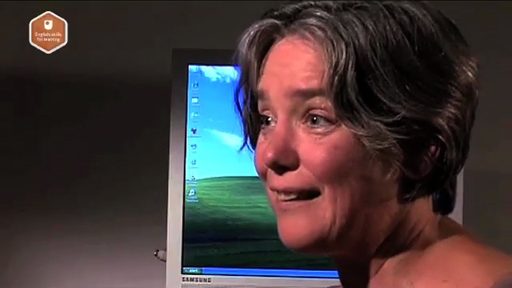
Transcript
2.2 Distinguishing between different types of assignment
It may be more common to find one kind of assignment type in a particular subject than in others. For example, science assignments may consist of short questions that require short answers, while a social sciences assignment might consist of short answers explaining a definition or essays explaining a theory. Regardless of the subject they are studying, students will probably have to write a variety of assignment types during their studies.
Activity 3
You are now going to gain an overview of some of the assignment types that you are likely to encounter in your university studies. Look at the list below of descriptions of various types of assignment. Match each assignment type with its appropriate description.
Report
An assignment that gives detailed information and analysis about a topic; it will often have different sections, with headings that have different functions; there is an introduction, different sections and a conclusion with recommendations
Short definition and explanation
A word or concept is briefly defined and explained
Essay
An assignment that focuses on one topic; it has an introduction, body paragraphs and a conclusion
Short-answer exercise
Brief answers in response to questions; the contents of one answer is not necessarily directly connected with the next
Summary
A short account of the content of something you have read, heard or viewed without details
Using the following two lists, match each numbered item with the correct letter.
Report
Short definition and explanation
Essay
Short-answer exercise
Summary
a.An assignment that gives detailed information and analysis about a topic; it will often have different sections, with headings that have different functions; there is an introduction, different sections and a conclusion with recommendations
b.A word or concept is briefly defined and explained
c.Brief answers in response to questions; the contents of one answer is not necessarily directly connected with the next
d.A short account of the content of something you have read, heard or viewed without details
e.An assignment that focuses on one topic; it has an introduction, body paragraphs and a conclusion
- 1 = a
- 2 = b
- 3 = e
- 4 = c
- 5 = d
Comment
During your university studies, you will be asked to complete a variety of assignment tasks to demonstrate what you have learned. Having a good understanding of what is required in the various assignments that you are asked to produce for your university modules will help you fulfil the task and get better marks.
2.3 Typical challenges
Writing a university assignment can be difficult. The following activity identifies the main challenges.
Activity 4
Below is a list of challenges typically experienced by students who are new to assignment writing. Think of your experience of writing longer and possibly formal texts. For example, you may have had to write a job application or a formal email. If you haven’t had such experiences, you may want to think back to your school experiences. Have you ever experienced any of the challenges listed below?
- It’s a very long time since I’ve done anything like this. I’ve forgotten how to do it.
- I’m not familiar with the British educational system. What is done in my country is quite different from what is expected here.
- I’m not clever enough to write an assignment.
- How do I organise essays and reports?
- I don’t understand the assignment title. What am I expected to do?
- I look at the blank page. I don’t know where to start or what to write.
- I can write short informal pieces but I have never written a long formal essay.
- I write too many words.
- I make too many errors and don’t know how to choose the right words.
Type your comments in the box before comparing them with mine.
Comment
The main problems students experience are caused by lack of experience and, in particular, difficulty in getting started. These difficulties arise when students have problems understanding the question and the way in which essays and reports should be organised. Some see assignment writing as daunting as it is a completely new experience.
The next section will address these challenges by focusing on the writing process.
3 The essay-writing process
Writing a successful assignment is less daunting if it is seen as a process consisting of several manageable steps. You will probably be familiar with some of these steps already: for example writing notes, putting ideas in order, selecting ideas to include, reviewing and rewriting what you have already written in order to improve it.
Another key point is that anyone writing an essay has to give themselves enough time. Generally the best assignments result from doing a little at a time over a period of days, rather than attempting to complete an assignment in one evening.
In this section you will look at this step-by-step process.
3.1 Some useful strategies
In the next activity you will look in more detail at the challenges often faced by students and the strategies they can use to complete an essay.
Activity 5
In the videos below, three students describe their writing process. They also mention the challenges they face and some of the strategies they use. Watch the videos and identify the challenges and strategies each student uses. Note them in the boxes below before comparing your answers with mine.
Diane
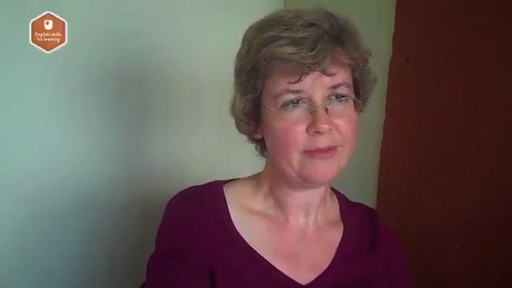
Transcript
Answer
Challenges
- Writing too many words
- Risk of not answering the question
Strategies
- Reading the question
- Reading in order to find answers to the question
- First writing everything you know, then revising it
Hugh
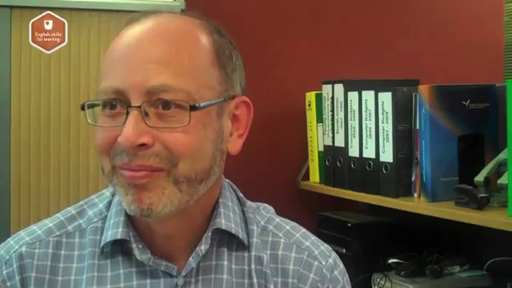
Transcript
Answer
Challenges
- Not enjoying essay writing
Strategies
- Using the structure given by the assignment
- Writing thoughts about each section
- Revising the answer many times
- Circular revision process: rereading, rewriting, reviewing, rereading …
- Stopping when the answer has been answered properly and completely
Christophe
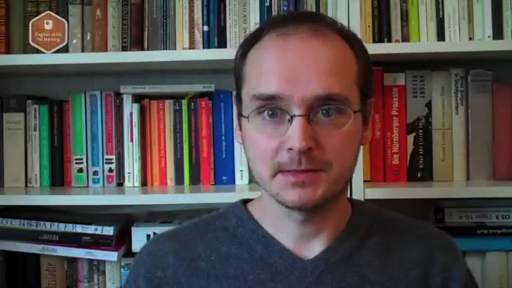
Transcript
Answer
Challenges
- Becoming too used to his answer
Strategies
- First, making a list of key points
- Then, carefully arranging these points
- Writing the first draft
- Asking someone else to read this draft
Comment
Coping with university writing is about developing strategies that help to meet a range of challenges. These students seem to have been successful in essay writing despite the various challenges they mention. They have dealt with those challenges by adopting strategies for planning what they are going to write, structuring the content of their essays and reviewing the text over and over again.
3.2 A step-by-step process
The next activity introduces you to a method that exploits all the strategies described by the three students.
Activity 6
In this activity you are introduced to the different stages of the essay-writing process. This process starts with activities that include reading (understanding the ideas of others), brainstorming (thinking of all you know about the topic) and note making, and proceeds through one or more cycles until you feel you have produced a full and correct answer.
The boxes show the eight stages in the process of completing an assignment. Drag each stage into the relevant blank box in the diagram.
Comment
Writing a university assignment involves going through a series of stages. It is quite normal for all writers to want to go through the cycle more than once. This may happen for many reasons. For example they may feel that they haven’t quite answered the question or they may want to go back to their readings and notes to find additional relevant material.
Many students find that the habit of breaking their writing process into manageable steps helps them not only to write university assignments but also other pieces of writing such as workplace documents.
In the next two sections you will learn how to plan an essay and a report.
4 Planning an essay: the pre-writing steps
Before writing an essay, it is important to take the time to understand its structure as this provides a useful starting point. A typical essay includes an introduction, the main body of the text, a conclusion and a list of references (Figure 3).
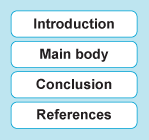
The structure of an essay consists of the introduction, the main body, the conclusion and the references.
While this is a simple structure, students often wonder what should be included in the main body of the essay. In this section you will learn how carefully reading the assignment question and carrying out some simple tasks can help you to plan the content of the main body of the essay.
4.1 Reading the essay question
Answering an essay question is only possible if a student knows and understands it. Reading the essay question is therefore a very important step that must be completed before starting the writing process.
Activity 7
a.
Write a plan of their essay using tables or diagrams
b.
Find the words that explain what they are required to do
c.
Start looking for the information they can use in the essay
The correct answer is b.
Comment
It is important to carefully study the key words contained in the assignment question to find out what it is asking the student to do. These key words as known as instruction words and content words.
4.2 Identifying the instruction words
Having a good understanding of instruction words will help you to identify what type of task you are being asked to do, which, in turn, makes it more likely that an assignment answer will be relevant. These words may seem complex but they are very often used in assignment questions. Understanding instruction words makes it easier to understand the requirements of most assignments.
In the next activity you will learn some of the key words used in assignment questions.
Activity 8
Listed below are eight of the most common instruction words. Match each one with its definition.
Compare and contrast
Look for differences and similarities between two or more concepts or things in an organised way
Discuss/to what extent
Give reasons for and against an idea
Illustrate
Make an idea clear by giving an example
Summarise
Give a shortened version of a written or spoken item, stating only the key points
Describe
Give a detailed account of something such as characteristics, a reading or an experience
Evaluate
Examine something to judge its value, importance, quality, or effectiveness
Analyse
Take apart an idea and examine it in great detail in order to understand it
Explain
Give details, clarify meaning or give reasons
Using the following two lists, match each numbered item with the correct letter.
Compare and contrast
Discuss/to what extent
Illustrate
Summarise
Describe
Evaluate
Analyse
Explain
a.Give details, clarify meaning or give reasons
b.Take apart an idea and examine it in great detail in order to understand it
c.Give a detailed account of something such as characteristics, a reading or an experience
d.Examine something to judge its value, importance, quality, or effectiveness
e.Make an idea clear by giving an example
f.Give a shortened version of a written or spoken item, stating only the key points
g.Look for differences and similarities between two or more concepts or things in an organised way
h.Give reasons for and against an idea
- 1 = g
- 2 = h
- 3 = e
- 4 = f
- 5 = c
- 6 = d
- 7 = b
- 8 = a
4.3 Identifying key content words
Having understood what type of task is required, you need to find out what content you have to focus on. This is done by identifying the content words.
The content words are words that express key ideas that you are expected to write about. In the following example of an essay title, the content words are highlighted:
Using examples from Chapter 3, describe some biological factors that influence the health of the individual (approximately 600 words).
Once the content words and the instruction words (in this case, using examples and describe) are clear, you should be able to rephrase the title to clarify it:
What are the biological factors that influence people’s health? I need to identify and give details about a few biological factors, and explain how each can affect health. I need to give some examples from Chapter 3 of my module materials to illustrate my
explanations .
4.4 Practice understanding the essay question
In the next activity you will practise identifying instruction and content words, and rephrasing questions into a simpler format.
Activity 9
Below are four essay questions. For each one complete the following tasks:
- Find the instruction words.
- Find the content words.
- Rewrite the task in your own words.
At this stage, you are not expected to know the content or the authors mentioned in these questions. Your purpose for reading them is to understand what each question asks you to do. Type your notes in the boxes before comparing your answers with mine.
- Compare and contrast our own education to date with that of one of your parents. Which points of comparison seem important to you and why?
Answer
The instruction words are:
- compare and contrast
- which important points of comparison …
- why?
The content words are:
- your own education
- one of your parents' education
- points of comparison
- important
This question can be reworded as:
Find similarities and differences between your education and either your mother’s or your father’s education. Decide which of these similarities and differences are the most important and explain why this is the case.
- Decide which
primate species you would prioritise for conservation action and explain how you came to this conclusion.
The instruction words are:
Answer
The instruction words are:
- decide which ...
- explain
The content words are:
- primate species
- prioritise
- conservation action
This question can be reworded as:
Which primate species is it essential to protect from extinction as soon as possible? Why should each of these species be prioritised?
- Why do people codeswitch?
Answer
The instruction word is:
- Why?
The content word is:
- codeswitch
Codeswitching describes the habit bi-lingual people have of using more than one language when they talk to each other.
This question can be reworded as:
Give many reasons why people codeswitch
- Describe the causes of
deforestation , explain its negative effects and evaluate the solutions that have been implemented to date.
Answer
The instruction words are:
- describe
- explain
- evaluate
The content words are:
- causes
- deforestation
- negative effects
- solutions
This question can be rewording as:
What are the causes of deforestation? Write about the negative effects of deforestation. Write down your ideas about how good the solutions to the problems are.
4.5 Producing a draft outline
The next stage is to write a draft outline. This can only be written on the basis of a full understanding of the question. The first draft outline helps to decide what to look for in any readings. However, after reading, it is normal to update the draft outline to reflect your improved understanding of the subject.
Look at this task:
Describe government interventions which may help people to tackle obesity. To what extent do you think these interventions can be effective? (800 words)
As this task asks the student to describe government interventions, each section of the essay will need to provide details about one type of intervention. It is also important to consider situations and reasons why an intervention is likely to be effective as well as situations and reasons why it may fail. Each point should be illustrated with examples.
This is a possible outline:
Introduction
Intervention type 1 – description – examples – why it can be effective?/not effective? + examples
Intervention type 2 – description – examples – why it can be effective?/not effective? + examples
Intervention type 3 – description – examples – why it can be effective?/not effective? + examples
Conclusion
Having written this plan it will be necessary to read the course materials to find:
- a definition of the term ‘government intervention’
- a definition of the term ‘obesity’ and some general information about its causes and effects
- examples of ineffective and effective government interventions
- theories about types of government intervention in the health sector.
4.6 Practice producing draft outlines
You will now look again at the essay questions you analysed in Activity 9 and evaluate different outlines that can be used to answer them.
Activity 10
Below is a list of assignment tasks. For each assignment look at the outlines provided and make notes in response to these two questions:
- Which outline best answers the question?
- What kind of information are you likely to need in order to write this essay?
| Outline 1 | Outline 2 |
|---|---|
| Introduction | Introduction |
| 1st codeswitching technique + example | 1st reason for codeswitching + typical techniques + examples |
| 2nd codeswitching technique + example | 2nd reason for codeswitching + typical techniques + examples |
| 3rd codeswitching technique + example | 3rd reason for codeswitching + typical techniques + examples |
| Conclusion | Conclusion |
Answer
- Outline 2 is the most appropriate because it provides a range of reasons why people codeswitch. It also explains the codeswitching techniques used and some examples that help to explain these reasons. Outline 1 is incorrect because it describes the techniques but doesn’t answer the question.
- To write this essay, it would be useful to find the following information in the course materials:
- definition of codeswitching
- theories about codeswitching, particularly reasons for doing so
- codeswitching techniques
- examples.
| Outline 1 | Outline 2 |
|---|---|
| Introduction | Introduction |
| Why conservation is important | Primate species that should be prioritised – brief description |
| Types of primate species | Reason to prioritise 1 + evidence + acknowledge reasons against |
| Primate species becoming extinct | Reason to prioritise 2 + evidence + acknowledge reasons against |
| The most important primate species | Reason to prioritise 3 + evidence + acknowledge reasons against |
| Conclusion | Conclusion |
Answer
Outline 2 is the most appropriate because it directly answers the question by selecting one species and using each paragraph or section to clearly give reasons for this selection. For each reason, the writer also shows that they have considered and dismissed a contrasting viewpoint (e.g. a reason for not selecting this species). This adds strength to the points they make.
The themes covered by Outline 1 provide background information but fail to directly address the question. As the requirement is to write only 800 words there is no space to provide much background information. Some of this (e.g. reasons why conservation is necessary) could be included very concisely in the introduction.
- To write this essay, it would be useful to find the following information in the course materials:
- definition of primate species
- list of species that risk extinction and their characteristics
- how important a species is to the environment: is it likely to benefit or damage it?
- theories of conservation
- examples.
| Outline 1 | Outline 2 | Outline 3 |
|---|---|---|
| Introduction | Introduction | Introduction |
| Point of comparison 1 (e.g. subjects studied) – similarities and differences – examples |
|
|
| Point of comparison 2 (e.g. teaching quality) – similarities and differences – examples |
|
|
| Point of comparison 3 – similarities and differences – examples | Conclusion |
|
| The most important points of comparison + reason |
| |
| Conclusion |
| |
| Conclusion |
Answer
Outline 1 answers the question because it identifies and develops several points of comparison and clearly compares and contrasts the two experiences. It also uses the last paragraph to indicate which one is the most important and why.
Outline 2 provides information about the two educational experiences but does not compare them. Therefore, this outline does not help to answer the question.
Outline 3 is also appropriate because it compares and contrasts the two experiences. However, the points of contrast need to be clearly mentioned when looking at similarities and differences. The last paragraph clearly indicates which points of contrast are the most important and why.
- To write this essay, it would be useful to draw from your own experience and to find the following information in the course materials:
- information about my own education
- education theories; in particular, factors that have an effect on people’s education as these help to explain the choice of points of contrast
- examples.
| Outline 1 | Outline 2 |
|---|---|
| Introduction | Introduction |
| Deforestation technique 1 | Cause 1 – description + example |
| Deforestation technique 2 | Cause 2 – description + example |
| Effect 1 – examples | Effect 1 – description + example |
| Effect 2 – examples | Effect 2 – description + example |
| Solution 1 – examples | Solution 1 – description + example + pros/cons |
| Solution 2 – examples | Solution 2 – description + example + pros/cons |
| Conclusion | Conclusion |
Answer
Outline 1 is inappropriate because it develops two paragraphs about deforestation techniques, which are not required. It does provide examples of possible effects and solutions but does not describe them. The solutions are neither described nor evaluated.
Outline 2 is appropriate because it clearly focuses on the three key content words included in the question: causes, effects and solutions. For each of these, it provides a description and some examples. When looking at solutions, it looks at reasons in favour of and against choosing them.
- To write this essay, it would be useful to find the following information in the course materials:
- information about deforestation: causes, effects, solutions
- theories about how forest management affects people’s lives and the planet
- examples.
This section has highlighted the importance of fully understanding the essay question as this helps to produce an appropriate outline. In the next section you will look at ways to represent outlines visually through a diagram.
4.7 Using diagrams to plan an assignment
Many students find that diagrams can be useful when planning their essays. This is because diagrams help them to think in a visual way about their essays and the ideas they need to include in them.
Look again at this assignment question:
Describe the causes of deforestation, explain its negative effects and evaluate the solutions that have been implemented to date.
This assignment can be outlined using a mind map as shown in Figure 4.
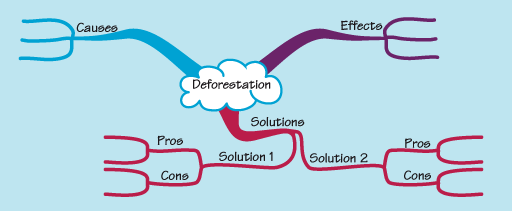
At the centre of this mind map is a cloud labelled ‘deforestation’. From this cloud stem three branches. From one branch, labelled ‘causes’, stem three branches. From another branch labelled ‘effects’ also stem three branches. From the third branch, which is labelled ‘solutions’, stem two further branches labelled ‘solutions 1’ and ‘solutions 2’. From each of these branches stem two branches labelled ‘pros’ and ‘cons’. From each of these stem two branches.
The mind map can be used while reading about deforestation to add information that could be included in the essay.
Activity 11
Draw a mind map that can be used to plan the following essay and to record the most relevant information from readings.
Decide which primate species you would prioritise for conservation action and explain how you came to this conclusion.
Before designing your mind map, look again at the suggested outline for this question. When you have finished, compare your mind map with mine and read the comments.
Answer
While reading about this topic and using this mind map (Figure 5), it is possible to enter each of the three reasons, details about explanations, evidence and alternative views and more branches.
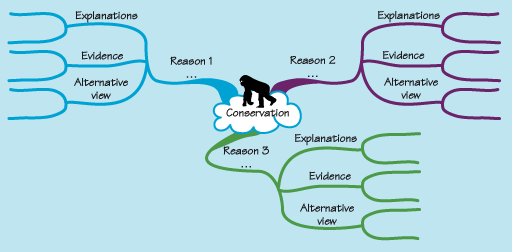
At the centre of this mind map is the word ‘conservation’. From this stem three branches labelled: Reason 1, Reason 2, Reason 3. From each of these branches stem three further branches labelled explanations, evidence and alternative view.
4.8 Using diagrams to plan a science assignment
Sometimes just reading an assignment question is not sufficient to write a draft plan. You will now look at a science assignment that requires students to describe and explain but provides no information that could help them to write a plan.
The assignment title is:
Describe and explain the greenhouse effect.
Just reading this title is insufficient to outline a text easily because the title does not contain helpful key words such as cause, effect or similarities. Before planning it is therefore necessary to read about this effect. Having done this, information needs to be arranged into steps as this will help to plan the text.
The following activity provides a useful visual technique for planning the essay.
Activity 12
Watch the following video in which Open University science tutor Phil explains to Zorica how to plan the assignment by using a diagram to visualise the information she needs to include.
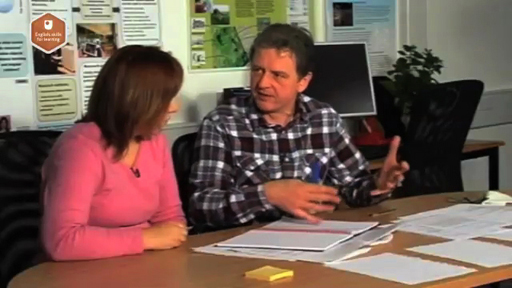
Transcript
Now put the following steps into order described by Phil and Zorica.
Infrared radiation emitted from the Sun.
Step 1
Absorption of infrared by the Earth.
Step 2
Re-emission of infrared to the atmosphere.
Step 3
Infrared absorbed by CO2 and H2O.
Step 4
Using the following two lists, match each numbered item with the correct letter.
Infrared radiation emitted from the Sun.
Absorption of infrared by the Earth.
Re-emission of infrared to the atmosphere.
Infrared absorbed by CO2 and H2O.
a.Step 2
b.Step 4
c.Step 1
d.Step 3
- 1 = c
- 2 = a
- 3 = d
- 4 = b
Comment
This activity shows the how diagrams can be used to both identify and present the steps of a process at the pre-writing stage. Depending on the number of words the student is required to write, they can then write either a paragraph or a longer text outlining each of the stages of the process.
5 Planning a report
Reports differ from essays because they normally follow a more detailed standard structure. Knowing this standard structure makes planning easier as it is only necessary to decide what specific content to place in each of its parts and for what reason.
This structure depends on the subject. The next two sections illustrate the structure of a science or technology report, and of a business report.
5.1 Planning a science or a technology report
Table 5 highlights the elements of a science or technology report, though the same general principles apply in other disciplines too.
| Element | Purpose | Description |
|---|---|---|
| title | attracts the reader’s attention | concise phrase or sentence introducing the content |
| abstract | gives a brief summary | short paragraph clarifying the scope of the report and the main findings |
| introduction | gives the purpose of the investigation being reported | explains why the investigation was undertaken and gives essential background information |
| main text | describes how the study was conducted describes how the study was conducted interprets results | the ‘meat’ of the report containing, for example (depending on the discipline):
|
| conclusions | describes what the study has shown | includes the meaning of the results of the investigation, what has been demonstrated and any recommendations for action |
When writing a report, it is necessary to assemble and order the material, perhaps under a set of headings (which can be added to or subdivided). The plan will help to include material that is relevant and to the point.
5.2 Planning a business report
Business studies reports follow a structure that is very similar to those normally written to help management to make decisions. The main purpose of these reports is to describe a real life business situation and to provide a list of recommendations.
While the overall structure is similar to that of a science or a technology report, the main text is usually structured using a ‘business model’, i.e. a framework that helps the writer to analyse a situation by looking at its specific features.
The following assignment task is structured using a SWOT model. SWOT stands for:
Strengths
Weaknesses
Opportunities
Threats.
In other words, it is a framework that analyses a business by looking at its strengths and weaknesses as well as at any opportunities it can exploit and the threats it faces.
Below is a business studies assignment question:
Use a SWOT model to analyse the multinational company Coca-Cola.
Table 6 shows how this report should be structured.
| Element | Purpose | Description |
|---|---|---|
| Title | Attracts the reader's attention | Concise phrase or sentence introducing the content |
| Executive summary | Gives a brief summary | Section or paragraph explaining the purpose of the report, the main findings and the recommendations |
| Introduction | Gives the purpose of the investigation being reported | Paragraph providing background information and explaining why the investigation was required |
| Method | Explains how the investigation was conducted | Explains why a particular model has been used and how the data was collected |
| Analysis | Examines the situation in great detail using the SWOT categories | Four sections or paragraphs under the following headings:
|
| Conclusion | Describes what the study has shown | Paragraph briefly summarising the findings, i.e. the content of the analysis and highlighting the key factors |
| Recommendations | Suggests future action | Paragraph or bullet point list of recommendations based on the findings |
6 This week's quiz
Well done, you’ve just completed the last of the activities for this week's study before the weekly quiz.
Remember the quizzes will let you check your understanding of what you have learned while also helping to prepare you for the badge quiz at the end of Week 4. By completing the weekly quiz you’ll also know how the quizzes work before you complete the badge quiz. So, it is a good idea to make time for them if you can.
Go to:
Open the quiz in a new tab or window (by holding ctrl [or cmd on a Mac] when you click the link).
7 Summary
This week you looked at everyday writing, at different types of university assignments and at useful ways to break the writing process into manageable steps.
These are this week’s key learning points:
- Writing is a daily activity for most people.
- Writing is easier if you know why you are writing and how to organise ideas and information.
- Assignments are written to show a tutor that the student has understood and can use the ideas and information learned from the course materials.
- Essays and reports are two common types of assignment.
- A range of strategies can be used to deal with the challenges of assignment writing.
- A useful way to approach assignment writing is to follow a process that consists of several manageable steps.
- The first step involves understanding the instruction words and key ideas contained in the question.
- The second step consists in producing a draft plan and deciding what kind of information will be necessary to answer the question.
- Mind maps and other diagrams can help to plan essays and organise notes.
You can now go to Week 4.
References
Acknowledgements
This course was written by Anna Calvi.
Except for third party materials and otherwise stated (see FAQs), this content is made available under a Creative Commons Attribution-NonCommercial-ShareAlike 4.0 Licence.
The material acknowledged below is Proprietary and used under licence (not subject to Creative Commons Licence). Grateful acknowledgement is made to the following sources for permission to reproduce material in this unit:
Images
Figure 1: (left) © Stacy Spensley in Flickr made available under https://creativecommons.org/ licenses/ by/ 2.0/; (middle) The CV Inn in Flickr made available under: https://creativecommons.org/ licenses/ by/ 2.0/ deed.en; (right) From: http://www.stickypadblog.com/ wp-content/ uploads/ 2012/ 10/ fridgesickypad.jpg; Figure 2: (left) © Stacy Spensley in Flickr made available under https://creativecommons.org/ licenses/ by/ 2.0/; (middle) © Scott Feldstein in Flickr; (right) The CV Inn in Flickr made available under: https://creativecommons.org/ licenses/ by/ 2.0/ deed.en.
Every effort has been made to contact copyright owners. If any have been inadvertently overlooked, the publishers will be pleased to make the necessary arrangements at the first opportunity.
Don't miss out:
1. Join over 200,000 students, currently studying with The Open University – http://www.open.ac.uk/ choose/ ou/ open-content
2. Enjoyed this? Find out more about this topic or browse all our free course materials on OpenLearn – http://www.open.edu/ openlearn/
3. Outside the UK? We have students in over a hundred countries studying online qualifications – http://www.openuniversity.edu/ – including an MBA at our triple accredited Business School.
Copyright © 2014 The Open University
